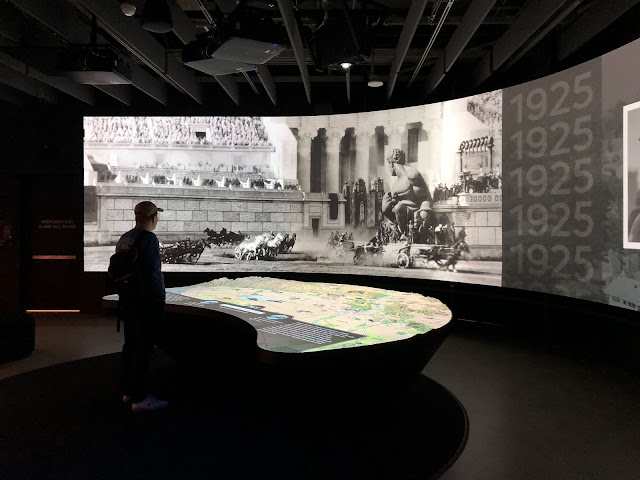In the wake of #OscarsSoWhite, many of the Academy Museum of Motion Pictures' debut exhibitions (2021) celebrated minority filmmakers who had succeeded in an industry that marginalized them. Some felt the museum was ignoring the elephant in the room: the marginalized Jewish founders of L.A.'s motion picture industry. Donor complaints led the museum to vow to create a permanent installation on Hollywood's Jewish origin story.
My bad is not usually a promising start for a museum exhibition, but in this case the story is compelling. "Hollywoodland: Jewish Founders and the Making of a Movie Capital" is smaller than you might expect, given the advance publicity, and contains no original artifacts. Its three elements are an introductory film, a projection-animated relief map of Los Angeles, and a wall of illustrated text panels on the eight major studios.
Unlike many an exhibition film, From the Shtetl to the Studio: The Jewish Story of Hollywood, does not simply duplicate the material you're about to see. It draws heavily on Neal Gabler's classic history An Empire of Their Own (Gabler consulted on the exhibition). It's a story built on irony, a device that Sam Goldwyn both embodied and pretended not to understand. Polish-born Goldwyn (originally Szmuel Gelbfisz, changed to Samuel Goldfish for business reasons, and then to Goldwyn) was an outsider in American society. Yet he and his peers invented a more decent version of America for their films, even as antisemitism raged. Hollywood's Jimmy Stewart fictions came to epitomize American values to the rest of the world, and ultimately, to Americans themselves. Not the least of the ironies was that the studio heads shied away from depicting Jews onscreen, and perpetuated jokey stereotypes about persons of color.
Two villains of the tale are Thomas Edison and Henry Ford. The automaker was a notorious antisemite who targeted the film industry. Edison is a more conflicted case, with parallels to today's AI-besotted tech companies. Edison did not invent the motion picture camera, as he claimed, but he improved it. He assembled a consortium of other patent holders who collectively claimed rights to virtually all motion-picture technology, demanding a royalty on use of their hardware. They sent out thuggish enforcers to shut down unauthorized sets with rubber bullets and got Kodak to agree not to supply film stock to unlicensed productions.
This encouraged production in Los Angeles, which then seemed very far from Edison's bullets and attorneys. The city came to be the home of eight major studios, each headed by Jewish moguls. The exhibition's animated map and curved projection screen presents a timeline of studio history and Los Angeles real estate from 1902 to 1929. By that point the studios were not shy about exploiting their bargaining position and intellectual property rights.
Text panels on the studio system summarize genealogy (nepo bros aplenty), corporate history, and the evolution of logos. One thought is how studio logos were important to later artists such as Ed Ruscha (20th-Century Fox) and Jack Goldstein (MGM). Another is that, in 2024, a news spinoff of Wilhelm Fuchs' (William Fox's) studio may decide the fate of Jimmy Stewart's America.
Curated by Dara Jaffe, "Hollywoodland" becomes the museum's first and only "permanent" exhibition. Like Michael Govan's LACMA, the Academy Museum is committed to rotating exhibitions only. In theory this challenges the textbook view of a single linear narrative. In practice it can mean that there's only room for one linear narrative at a time. Located on the museum's third floor, "Hollywoodland" replaces a long-running installation of pre-cinema objects, from magic lanterns to the Lumière brothers—an equally essential origin story predating Hollywood and Edison.
 |
| Installation view of "The Path to Cinema: Highlights from the Richard Balzer Collection" (closed Mar. 12, 2024). (c) Joshua White/JWPictures |




Comments
I wonder if LACMA's new building next door is going to open without delving into the history of European art, at least from before the 1950s or 1920s?
That would have been pure sarcasm in the past, but not so much today.
Dude can't help himself.
That the AMPAS museum premiered in 2021 intentionally leaving out a big facet of the history of the movie industry (for political, not light-sensitive reasons) is why arts and culture in the 2020s - including movies--SAG-WGA strike or not - seem to be increasingly exhausted or way too self-consciously ideological.
Also, is the AMPAS building so small that one fundamental topic (the history of Jews in Hollywood) has to push out another fundamental topic (pre-cinema objects)?
If LACMA opens its new building with galleries devoted to supposedly older European art but instead tries to insert the story of contemporary European art that will be another case of today's cultural influencers or decisionmakers being into their hipster form of same 'ol, same 'ol. However, Govan's/Zumthor's structure is admittedly smaller than the space it's replacing, so there's that.